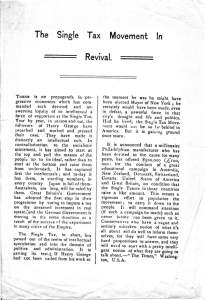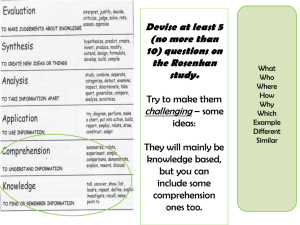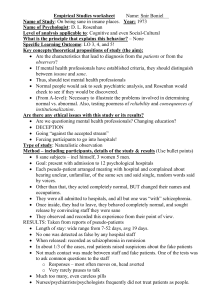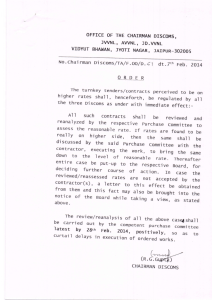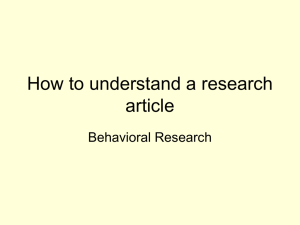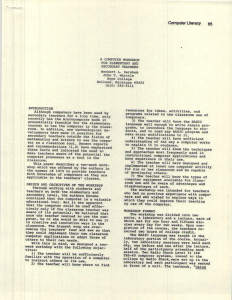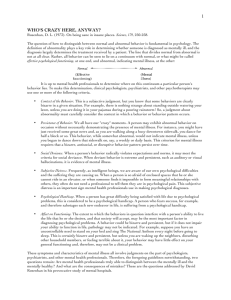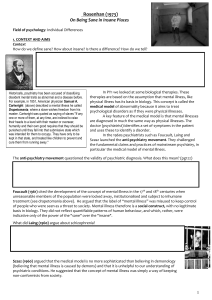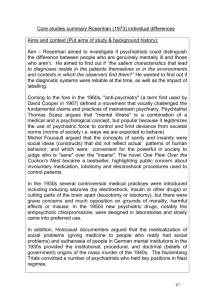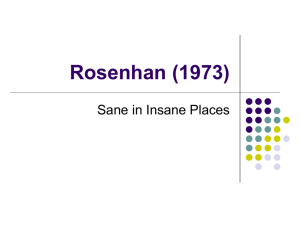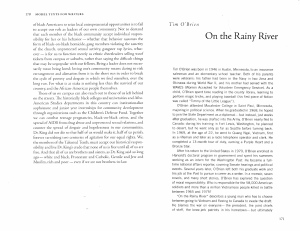psychopathology - HallquistCPHS.com
advertisement
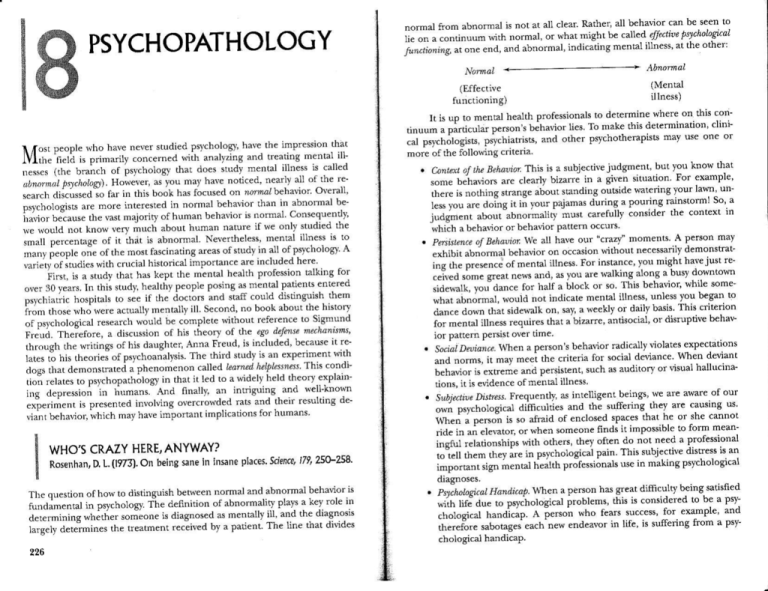
PSYCHOPATHOLOGY
can be s€en to
normal from abnormal is not at all clear' Raiher all beharior
t
b
e
atted
4l'ttiLt" P \' hotagnl
,..,r"'"rn*,nnormdl or $ hdr might
ii.
ar rhe otier:
illnes'
".1
menl2l
l!, /ro,r,g. dr one end. drd dbrormdl indi'arrng
(M€ntal
illness)
(Effective
functioning)
It is Lo ro mcnral healh protesrionals ro
rr"'
h'rue rhe :mp asron rhat
]t ,fo.. p.opl" \vho have nereFrudied Psr holoqlr
and rrenrrng menuL rrrwirlt
dnrl\/ing
pnmJri\
,oncernFd
lVhne n.ta i.
Lud\
aenral illne;s callcd
ooc'
rhi
re*e' rrh. b-an.h or p.}r holog'
nea'h dll oilhe rF
nori'ed
hJ\e
ma)
dbno,.tl t\,\ota|. ) H"w.'e' .s1o'
oterdll'
on
ha
locuied
,.,'.1 ai***aio r^ in rhi: bool
'o'aalbehavro
beabnornal
r\'rn
rn
Dchr\ior
normal
.".fr.r.n"".re ro'e inrere'red in
(
onrequ"nd)'
r(
normaL
behd\ror
m4orlq ol humdn
'r,".^, rnuch about human naNre if rve only studied Lhe
",tr"'
'r"i,r* f.".*
*."1a
t".
"., or'".y
ir Lhar is dbnorlrJl Ne\e'Ihel"\' nenul illne$ i' Io
.mzll per.FnLage
tl'emosr ldrciririns leas ol 'rud\ inallolPr\Lhorogl {
-,"'i-"r..i..r
*r ien of nudie. sirh c, u, rdl hisrorr.al rnpo'tjn'e are rn' luded here
lor
Firi, is d.,ud! rhar h^ kePr Ihe mentdl hcal h profe(ion ulkrng
Fnrered
d5-nenrdl
.'" iO'*^ ln rhi''tudv'ealrh' people Po'irg(tdf (ould P'rint' rhem
di'Lingurh
n{!hi"Lflc hosoilal' ro 'cF rl hF do'rors dnd
j'onrrt
abou' the hi'ton
no
bool
o'".nj'."'e,.,u"llym"nullvill setond.
ro \ig-Lnd
qould
(orplere
\rrhour
rereren'e
bF
Ierarch
"r,J.ra
".'.r'.f*i,,r
n 'ha';\^'
Pga
dPh"v
ot
he
rn"ierore, a dr"cu'(ion ol hj'rheory
ir rein'luded
be(ause
i'
rhrousl, Lh. riine. of hi. daughrFr' A'c 1, freud
\virh
F)'pFr
rmenr
i5
ud\
,r'..''" .,,r.-' i.i.i p"' no,n,t"i'. rhe' hir d'r
"n
rondr
Tht'
htlh*t^'
i.,. ,i.,' a.-.^",'.i ., phenomenon:r' alled bavcd
. o'r.hooarhoron in rhat leil ro a \vidFl\ held rheoN erPlarn""i*r"*r
.ns J"p'"*ron ;n r.,ma.' tu d fin.rllv dn inrigLring rnd $ell-tnown
i. p'eGn ed rnvol!:ng overcrotded rats and rherr re'Llrrng dn
"'"-i-.''
\i2nr behavior. \hn h mr) hd\F ;mporranr imPli" on' or hum'ns
I
I
I
'r"--ps)(bologrsts
" "IrA,
(al
t
179'
.
.
.
a.,..-;"i.g "'}ri,r.* -ri"one
i"'glry a.r"i'"i"* ,L. ,r'eatmenr reciived bv a patient
226
jr,dgm.nr about abnormal:r)
which a behavior orbeha!'ior Pattern occurs'
may
P^i'bnce of Behadar $re all have our "crazv" moments' A Person
demonstratnecessadly
without
exhibit abnorrnat behavior on occasion
rei.n,ft. **.*..f.""tal
'llne5s For ins!!n(e )ou mighr ha\e iu'3r
dosn'own
bus\
alons
wdlking
ne$\ and as )ou are
;;,".;
' $hi]e some
';trr. "*,' tor hau a blo'k or rc' thrs behdvior'
.ia"..[.
-.ia"n- nor indicare menl:l illnesc unle's you began Io
uUno'*rr,
"o,fa
"r'ur
Thi' Lrircrion
dan.e down tha$rdFwall on 'ay i heekl) or daily basis
behavial
ordi'ruPuve
lormental :llne(s iequrre' rhaL ;' bi/a're anti'o'
ior patlern Persisl over time'
when a person's behavior ladically violares expectations
Wh€n deviant
.tJ".t.t, i, -"y -*t the criteria for social deviancevisuai
hallucinaor
auditory
as
such
persistent,
i"f,uuio, f .r.t e-. a"a
rions, lt is evidence ofm€ni21illness
5lkpttL.D"h.- FrequFnrh as jnrelligenr being' we arc a$are ofour
Social Detiance
""i
wh.;"".la.n',"r
, p.r.."" i'
The line that divides
diin.ulrie' and lhe tuffering rhev are 'dusing us
to atraid ol cnclored sPace! rhaL he or she (annor
someone finds it imPossible to form meanorhers rhev ofLen do not need a Prolessional
ai eleutor, orwhen
i".r"i-'.r",.'.r'ip' '',r'
ir'.. ,r."y "" i' p()rhologi'r'1 pain lhi( subiFCuve disuess is an
'li.ii
menral heallh Prole.,iondls use in md(ing P'v'hologrLar
imporranr
I
is diag"osed as mentallv iU' and the diagnosis
P{Lhidui'Ls.
aonL,^t at ,h. Behoua,
250-258'
i(
lLe aJF'ron ol ho\ ro disr'nguish ben'een rrormal and dbnorm'l beha'ior
role
a
ke\
r."al-." ,r in p1, ho)o$ The delinirion ol abnor maliq Pla\'
'n
behavior liec To make this dererminalron cliniand orher psv(horheraPisb mav use one or
Thi' r' d "ubje'rite iudgmenr' bur )ou know thar
e)'JnPle'
,ome s.ha'lon are clear\ biTdrre in r giren "jtuarion For
vou'
lawn unii.," i' "-r.i"g ''*"g. abour sundrng outside wareringIainrto''rn:
50 a
les' 1ou aredohg ir rn 'our pajama' during a Pou)ing
rn
rhe
conrexL
mu"r (arefulh consider
.
wrlo's cRAzY
Rosenhan, D
'
more of rhe folto$'ing criteria
ride in
HERE, ANYWAY?
(17f,). On being sane in in$ne pta(es srience
person
deler mine where on lhis ( on-
.
diagnoses.
'ign
P'\.holo.J.t:al Honditop
uten
a person has grear
dim'ulry being rali'fied
ro psyihotogicat proslems chi: is (onsidered ro be a Prvand
.r'.i.n.,r n-allp. A ;**; *h' fears success' for examPle'
psv'
a
from
is
suffering
in
life'
endeavor
;'"."ri.. ,ubotug"' .uch new
J,r, iiri a".
chologicai handicaP
.
The extent to which the behaviors in question interfere with a person's abiliry to live the life thai he or she desires, and
that society will accept, may be rhe mos! important facror in diagnosing
psvchologlcal problems. A behavior could be bizare and persistent, but
if it does not impair your ability to fun.tion in life, pathology may not
be indicared. For example, suppose you hale an uncontrollable need to
stand on )our bed and sing The National Anthem every night before
going to sleep. This is certainly bizarre and persisient, but unless you
up th€ neighbors, disturbing other household members, or
are
'raking
feeling terrible about it, your behavjor mal have litde effect on your
general functioning and, therefore, mal not be a clinical problem.
EJIect on Fun.tioning.
These stmptoms and characteristics
of mentai
illness
all
involve
judgnents on the patt of psychologirts, psychiatrists, and other mental health
professionals. Therefore, the foregoing guidelines noN-ithstanding, two ques-
rions remain: Are menral health professionals rruly able to distinguish betw€en rhe mentally ill and the m€ntally healthy? And what are the
consequences of mistakes? Th€se are the questions addressed by David
Rosenhan in his provocative study ofmental hospitals.
THEORETICAT PROPOSITIONS
Rosenhan questioned shether the characteristics tha. lead to ps,v€hological
diagnoses reside in th€ patients themsehes or in lhe situatjons and contextr
in n'hich the observ€rs (those irho do the diagnosing) find the palients. H€
reasoned that if the established criieria and the training mental health professionals have receiled for diagnosing mental illness are adequare. then
those professionals should be able to distinguish bet\deen the jnsane and the
sane. (Technically, the words sane and insane arc t€gal terms and are not usuall) used in psychological contexb. Th€y are used here because Rosenhan jncorporated them into his research.) Rosenhan proposed tha! one way to test
mental health professionals' ability to correct\, categorize would be to have
be
normal people s€ek admittance to psychiatric facilities to see if they
'\'ould
discover€d to be, in realitf, psychologically healthl If these "pseudopatients"
behaved in rhe hospiial as rhey$ould on the ouiride, and iftheywe.e not dis'
co\,ered !o be normal, fiis lt'ould be evidence that diagnoses of t}le mental\
rll dr" rrFd "nore ro r\. (iru/ron rhan ro rhe pdtient.
plained ofhearing voices that said "emPq'," "hollo1i" and "$ud " Other than
rhis single sf$ptom, all subjects acled comPletely normallv and gave totally
truthfui information lo lhe inFrvjewer (except that r,hey changed their
names and occupations). All the subjects were admitted to the larious hosPitals, and all bu! one $as admitied wirh a diagnosisof schizalhrcnia
Once inside the hospital, the Pseudopatients disPla)€d no slmp.oms
whatsoever and behat€d normallv The particiPants had no idea l'hen lhey
would be allowed to leave lhe hospilal. It was up to them to gain their rel€ase
bl convincing the hospjtal staff that they wer€ healthy enough to be discharsed. All the subiects took notes of their exPeriences At firsl, they tried to
conceal this activiry but soon it w:s clear to all that this secrecy las unn€cen
sary, because nolaraAtng ,ena"o/ was seen asjust another symPtom ofth€ir illness. They alt desired to be released as soon as possible, so they behaved as
model patients, cooperating with the staff and accePting all medications
(which were no. s$'! lowed, burflushed down the toilet)
RESULTS
The length of hospital stal for the Pseudopatients ranged from 7 days to 52
days, with an average stay of 19 da)6. The key Iinding in this study was that
not one of the pseudopatients $'as detected by anyone on rhe hospital stalf
\vhen ihey $€re released, their mental health status rvas recorded in their
ljjes as schizofhrenia in rcmissian. 'fherc were other inreresring findings and
$hiie
the hospital's statrofdoctors, nulses, and attendants failed to de'
tect the subjects, the other Patienrs could not be so easil)' fooled ln three of
the pseudopatients' hospitalizations, 35 out of 118 real paiients voiced suspicions that the subjects were not actually mentally ill. They would make com'
m€nts such as, 'You're not crazyl You're a journalist or a rcpofter, You're
che€king up on the hospital!"
Contacts between the patienG h{hether subjects or not) and the sta.ff
$'ere minimat and often bizarre one ofthe tests made by the Pseudopatients
in the study was to approach Brious staffmembers and auemPt to mak€ verba1 contact by asking common, normal questions (e g., When will I be al-
loNed gmunds prililegesl or Wlen am
I likely ro be dischargedl) Table r
summarizes the responses they received.
METHOD
Rosenhan recruited eight subjectr (including himsell to seFe ar pseudopatients. The eight participants (three $'omen and five men) consisted ofone
graduate student. three psychologists, one pediatician, one ps,vchialrist, one
painter, and one homemaker. The subjects' mission was to present th€mselves for admission to 12 psychological hospitals, in five srates on both the
ea-st and west.oasts ofthe United States.
A1l the pseudopati€nts followed the same instructions. They called the
hospital and made an appointment. Upon arir?l at dre hospital t}tey com-
TABLE
1
Responses by Doctors and Stafi
RESPONSE
Lloves on, head averled
lo Questions Posed by Ps€udopatients
PSYCHLATRISTS f,4)
NURSES AND ATTENDANTS (%)
71
88
23
10
?
2
0.5
(Frcm
p 255.)
tihen the pseudopatient received
a response, it frequendy .ook the fol-
lowhg form:
Could you tell me when I am
PSEUDOPATIENT: "Pardon me, Dr
elisible for srounds privileges?"
PSYCHIATzuST: "Good morning, -Dale How are ),ou todayi"
.her mo\ed on urrhou \Jir:ng for. respon.".
In contrasr lo the se!€re tack of personal contact in the hospibls studied, rhere $a! no shortage of medication. The eight pseudoPatients in fiis
studt lvere given a total of2,100 Pills fiat, as mentioned, were no! ${allo\a€d.
The subjects noted that mant of the real patjents also secretly disPosed of
their pills doun the toilet.
Another anecdote from one of rhe pseudopatients tells of a nurse who
unbuttoned her unlform rc adjust her bra in front of a dalroom full of male
patients. Ii was not her intention to be Provocative, according to the subject's
T\,
The pseudopalient had a clos€ rclationship with his mother, but Ms rather remote with his fa$er during hh early childhood. Dudng adolescence ed beyond, honever, his father became a very close friend while his relaiionship with
his morher cooted. His present relationship with his wife @s chamcteristlcalll
close and wam. -A.part
fron occsional
angry exchanges,
ftcdon
was
ninimal.
Th€ childrcn had raiely been spanked. (p.253)
The director's interpretation of this rather normal and innocuous his-
do, ror
report, but she simpl), did nor consider the patients to be real people.
DtscusstoN
Rosenhan's siudy demonstrated that normal people often cannot be distinguished from the mentalry i1l in a hospital setting According to Rosenhan,
this is because of lhe oveffhelming influence of the Psychiatric-hospital setting on the staffs judgmenl of the individual\ beharior. Once patients are
admitted to such a faciliq,, there is a stmng tendenq for them to be !ie\'€d in
Nars fiat ignore their individuali+ The auiiude created isr "lf they are here,
ther must be crazy." More important, is Nhat Rosenhan refers to as the
stichiness of the diagnostic lard That is, when a Patient is labeled as r.iilo1ircntc,
it becomes his or her central characteristi. or Personality tmil' From the moment the label ls given and the siaffknows it, they perceive all ofthe patient's
behalior as stemming from the diagnosis, thus, the lack ofconcern o. suspicion oler the pseudopatients' note taking, i{hich was perceived as.just an'
other behavioral manifestation of the ps,vchological label.
The hospital stafftended to ignore the siiuational pressures on Patients
and saw only rhe behalior releBnt to the pathology assigned to the Patients.
This was demonstraled bv the follo$ing observarion ofone of the subje€ts:
Onp p., h:dtri.' potn ed .o, g,odp ol pdtie.r' 'ro trPre n _8 oubrdP 'hF
, aferr k .' ,r"n . h..f,n \our berorF lun,l-r,ne. To a group of ro ,.8 rc.idPn'
\' oralD.v.h-arid, he inor.".ed ,hr_ .u.h br\dq. ra" hda(rrr" (
l,qu"'u'- n""'.
or ,he cndrome
rve;e simp\ verl few things to do
i!
"l
lr .eea.d no' 'o o\Lu' 'o hrn
'hrr $ere
hospital besides eating (P 253)
a psychiaL.ic
Beyond this, the sticky diagnosiic label even colored horv a pseudopadent's ,irlorywould be inrerpreted Remembet atl the subjects gave honest
accounts of theh pasts and families. Here is an example from Rosenhant research of a pseudoparientt stared hisiorli followed by its interpretation by
rhe staff doctor in a report after the subject was discharged The subject's
rrue histon $'as
as
follows:
This $hn€ sg-year-old maie manifests a long history of consid€rabl€ ambi"lence in close relationships which begins in early childhood. A rdm relationship with his mother cools during his adoles.ence. A distanr relationship with
his father is desc.ibed as becomingvery intense. Affective stabiliryis abs€nt. His
auempis to control emorionaliry with his wife and children are punctuated by
angry outbursts and, in the cde of the chjldren, spankings. And while he srys
he ha several good friends, one senses considet?ble ambnalenc€ emb€dded
those relationships also. (p. 253)
in
There l{as no indication thar any of the stafs distortions \4€re done inkntionally. They beheved in the diagnosis (in this case, schizophrenia) and
interprercd a patient's history and behavior in wa)'s that $€re consist€nhsith
that diagnosis.
SICNIFICANCE OF FINDINCS
$e mental health profession. The resulr, poinkd
out tlvo crucit facton. First, it appeared that the san? could not be distinguish€d from t|]|,e insane in mental hospitat settings. As Rosenhan himself
stat€d in his article, "The hospital itrelf imposes a spe€ial environment in
which the meaning of behavior can be easill misunderstood. The consequences to patients hospitalized in such an environmen! . . . seem undoubredly counterthempeutic' (p. 257). Second, Rosenhan demonstrated the
danger of diagnostic labels. Once a person is labeled as having a c€rtain psychological candition Guch as schizophrenia, manic'depressive illness, etc.),
thar label eclipse, any and all of his or her other chamcterisrics. All behavior
and personaliry characteris[cs are seen as stemming from th€ labeled disorder The wont part of rhis sort of treai,rent is that lt can become selfconfirming. That is, if a person is treated in a c€rtain way consistendy over
Rosenhan s stud) shook
time, he or she ma)' begin to behave thar way.
Out ofRosenhan's $'ork grew greater care in diagnostrc procedures and
increased a$Breness of the dangers of app\'ing labels lo patients. Additionthe decrease
ally. the problems addressed bv his study began to decline
'r,ith
in patients confrned to mental hospitals. This decrease in hospital poputations rras brought about by the discovery and rridespread use ofantipsychoric
medications, which have the power to r€duce stlnptoms ir most patients
enough for th€m to live outside a hospital and in many cas€s lead relatively
normal lives. Concurrenr io this was the growth ofcommunity mental health
Excerpbd vith pemissioD riom Roscnhan, D.L. (19?3), "On BeinS Sane in lnsane Plac€,," S.n
fl.a I ?91250-258, Cop}1 ight 1973 Amencan Associar.io! for the Advancem€n! of Science.
r rLhouu0l0LDH)
facilities, crisis intervention c€nters, and beha\ior therapies that focus on spe,
cific problems and behaviors and tend to avoid labels atlogeth€r.
This does not imply b) any means that the mental health profession ha.q
eliminated labels. Howeler largely bccause ofRosenhan's research and other
research in the sam€ vein, psirhialric labels are now used carefully and
trerted rvith the respect their power demands.
QUESTTONS AND CRtTtCtSMS
One research and leaching hospjtal whose staff had heard abolrt Roscnhan s
findiDgs before fiey were published doubied rhar such mistakes in diagnosis
could be macle in their hospital. To rest &is, Rosenhan informed the hospital
staff thar during rhe nent t\ree monlhs one or more pseudopatients lvould
tr! !o be admitted !o their psychiatric unit. Each siaff member $as asked to
rate each presenting patienr on a 1o'poji]. scale as to the likelihood that he
or she ras a pseudopatient. At the end of thre€ months. 193 patients had
been admitted. Of those, 41 lvere considered
i{ith high confidence to
be
pseudopatientq b\, at least on€ staff member. Twenty,three llerc suspected bv
at Ieast one pslchiatrist, and 19 $€re identified ar pseudopatients by one psychiatrisr and one other staff member. Rosenhan (the tricky deril) had not
scnt anrr pseudopatienls to the hospital during the three-month periodl "The
expcriment is instructii'€," sntes Rosenhan. "lt indicates thar th€ rendency ro
desigrate sane people as insane can be relersed when the stakes (1n this case
prestige and diagnostic ability) are high. Bui one thing is certain:AnI diagnostic process rhat lends itselfso readily to massiv€ €rroN of this sorr cannot
be a \,err reliable one" (p. 252).
Rosenhan replicated this study several times in 12 hospitals beF\€en
1973 and 1975. Each time he found similar resl ts (see creenberg, 1981, and
Rosenhan, 1975). However oiher researchers dispute ihe conclusions Rosen,
han drew from lhis research. Spitzer (1976) has argued rhar while the meihods Lrsed by Rosenhan appeared to invalidate psychological diagnostic
slstems, in realitv they did not. For example, it should not be difficult for
pseudopatients to lie iheir way into a mental hospital, since man), such admissjons are based on !€rbal reports (and who would ever suspect someone of
,ing t.ickery to get inlo such a placet). Th€ reasoning here is that lou could
walk into a medical emergenc,v room complaining of sever€ intestinal pain
and yoLr mjght ger )oLrrself admjtted to the hospital with a diagnosis of gasrri
t's, appendicitls, or an ulcer Even though the doctor was tricked, the diag-
nostic methods Nere not in\ulid. Additionallx Spitzer has pointed our.hat
although rhe pseudopatienti behaved normally once admiued to the hospital, such slmptom ladation in ps,vchiatrjc djsorders is common and does not
mean rbar the staffr\'as incompetent in failing to detect the ruse.
The conrro\'€rs,v oler the validiq, of psvchological diagnosis rhar began
with Rosenhan's 1973 article continues. Regardless of th€ elentuat outcome,
there is little question that Rosenhan's studv reDains one ofthe most influen
tial in the history ofpsy.holog.r'.
RECENT APPTICATIONS
tilo ofmany
\alidit/
of diagin challenging the
As an indication of this continuing controverst, we can consider
studies rhat hai€ us€d Rosenhan's research
noses made b]' mental heatth professionals. One ofthese is by Thomas Szalz,
a pslchiatrist who has b€en a w€lLkno n critic of the concept of m€ntat illness since the early 1970s. His contention has been that mental illnesses are
not diseares and cannot be properly understood as such, but rather must be
seen at pnblens in Litine that have social and €nvironmental causes. In one a.have been
ticle, he males the case lhat the dazt ,alfr exhibired by some
'r'ho
diagnos€d $'ith a mental illness "is not a valid reason for concluding that a
peffon is insane" simply because one person (the mental health professionat)
cannot comprchend the ol\er (the patieno (Szas?, 1993, p. 61).
Another study building on Rosenhant 1973 article examined how, in
some real life situarions, people may purposely fabricate symptoms ofmentat
illness (Broughron & Chesterrnan, 2001). The case study discussed in the alt;
cle involved a man accused of sexually assautting a teenage boy. $hen the
perpetrator {?s e!?luat€d for psychiatric problems, he displa,ved iarious psychotic behaviors. Upon further examination, ciinicians found thar he had
laked alt of his symptoms. The authors point out that tradirionally, mental
healrh professionais have assumed the accumcy ofpatient statements in diagnosing psychological disorden (as they did with Rosenhan's pseudopatients).
HoNeler they suggest that inv€nting symptoms "is a tundamental issue for all
ps,vchiatrists, especially lwhenl . . . complicated by external socio-legal issues
which could possibly sen'e as motivation for the fabrication ofpsychopathology" (p. 407). ln other words, we hale to be careful that criminals are not
able to fake menbl illness as a "g€t'out-of'jail free card."
How do t}l€ peopl€ themselves feel who have been given a psychiatric
diagnostic labetl In a survey of more than 1300 mental health consumerc,
\,'ahl, (i99S) asked about their orperiences of being discdminated against
and stigmatized. The majodty of respondents reported feeling the effects of
rhe stigma surrounding mental illness from \arious sources, ircluding community membells in general, family, church members, coworkers, and even
mentai healrh professionals. In addition, the author reported, "The majoriry
of respondents tended !o try ro conceal iheir disorders and worried a great
deal thar others would find out abour their psychiatric status and treat them
unfavorablv. They reporred discouragement, hurt, anger, and lowered sell
este€m as a result of fieir experiences and urged public education as a
means for reducing stigma" (p. 467).
Perhaps psychologisl-s are making some progess on the public educaiion front about mental illness. In a study by Boisvert and Fausr (1999), sub"
jects were presented vith scenarios about an employee who behaved in a
violent manner toward his boss. The scenarios varied in the amount of str€ss
the employee was experiencing, and in some of the scenarios the employee
was descnbed as having been pr€\'ious\' diagnosed with schizoPhr€nia. The
researcheN predicted rhat subjects would be more likely to attribute the
P$chopatholog
violence ro the employee\ personalio rrhen the schizophrenia label was attached, but r,ould lean more roward blaming ih€ environmental strcss irhen
rhere was no elidence ofmental illness. Guess $'hat. They foundjusr rhe opposile. As stress increased, the subjects blamed the personaliq, of the emplotee 1"$, regadless of the presence of the schizophrenia label.
Furthermore, the researchers obtained fie same results rvhether the participants r\ere real'life, practicing mental health clinicians or college students.
So, it is hoped rre can take some comfort in this evidence that tolerance
and understanding of mental illness is increasing. The realir/ is that, so far,
diagnosing mental illnesses continues to be as much art as it is science.
Chances are e $'i11 never do away (dth labelsi thel appear to be a necessary
part of effective treal'nenr of ps,vchological disorders, just as names of diseases are parr of diagnosing and treating physical illnesses. So, if we are stuck
with lab€1s (no pun intended),1\'e must continue to work to take the stigma,
emhrrr2ssmenr. and shame our of rhem.
Boislcll, C., & Fau$, D (1999). Effe.6 olihe label'\chizophrenia" on causal auribudotu otvio
|lnce. Srhizophtdia BLlletin, 2i, 419-491
Broughton,
N. & Cheserman, P
(2001). Malingered psy.hosis Jduthat
oJ
F en'i
Ps).hiatr!,
Creenbe.g,J (l98l,Jun€4ulr) An interyiewwirh Darid Rosenhan. l",1 Mo,i,,r 4-5.
L. (r 975). Th. contexh,al natu.€ of pslchiatnc diag\osn. Jatmal a.f Abnonal Pq"
thakg, 81,412-152
Spitzer R. L. (1976). Nlore on pseudoscience in sci€nce and the case of the psychiatic diagnosis:
A.riiique olD. L. Rosenhanl O! beingsane in insane places'and The contexrual na'
ru.. ofpsr.biatic diagnosis Arhirq aIGqqai Prchia,:l, ,,4,,9410.
Szasz, T (1993). Cm"y talk: Thought dnorder or psy.hiatic att g4 .er Aiish JamaL al Melli.at
Rosenhan, D.
PlJ&olas, 66, 6I-61
.
$Iahr O. (1999). Menial health consum€rt experience of srigna
S.nizaphfttuia BrllNrin,
2J(3),46t-4t8
YOU'RE GETTING DEFENSIVE AGAIN!
treud, A.(1946).
Internadohi
The ego and
ke fiechonltns oI
FrpenmeDll ro -eprescrr hrs worL. as has becn done lor orher
re_
searchds in rhis book. Freud's rheories grew our of carefut obsen?rions of
his patients oyer d€cades ofclinical analysis. Consequently, his writings
were
i:ast. The rnslish rranslation or his',co ectea #rngs,
*"19*:,9:".1
:n. ol th. t
Th€
onpbe Pr\.holoS,.at Walh: aJ S$nund Frtud ilon, 1953 ro 1974), rotais 24 volumesl
usly, only a veq'
small piece of h
could be discussed here.
In choosing
includ€ here. considerari
given to rh€ porhale stood the test of
r€latively unscarhed.
Over the past century a
deal of cdticism
focused on FreDd's
ideas and, in the last 40 ye
eciall). his
been drawn into serious
question from a scientific
aryued that many of his
theories either cannot be tesred
rifi
if they are tesred, they prove
to be generally unreliable.
few would doubr rhe hisrori.at
imporance otFreud, many of his dlYqbour the srructure of personality,
rhF developmen, or person"lir. rl-I
rhe D(vchosF\uai ,ogir, ,"a ;';
soLrrces of peopler psychorosicallFl& ha;e been rejected"\
most psy_
chorosis,,,od/,. Ho"e,",
r,orr, rr",e ierei,ea mo,e pIi_
tive.reviess throush the y*^g[6-"
rvide acceptance.
""j$erativety are weapo'ns that bne
of these i, his concepr of thgffnse mechan&,These
your
ego uses to prorect yon
yolt own setllftgated anxiety. This et€ment
ry
from his work has beengfted b represent F!l)d in this book.
Sigmund Freud'
of d€fense melknisms occurred gradualry
over 30 or more y€gtf his experiences in dealil\with psychologiial prob'<Fnes or
somrFtst.
A^cohfseFcontained
anlwhere in
lb
rsitl€s Prcss-
In r hook abo,1r rhe
ing figure would be ex
It is very unlikelt that psycho
varied and complex forms, $d
sponsible for elevatins our inl
. Alrhough \rgmu,rd Freud (d. inregrrt ro p$cholog\', hi,rory and.
rnererore. rr d nece\r'-y pd'r of rh:\ book. rhe task or inctuding hi! resea,.h
here aiong wirh all the ofier researchers was a difficult one. Tie reason
for
ttis difiicula was rhar Freud did not reach his discoveries rhrough a clearly
defined.sl ienufi. merhodotogt Ir \a, nor po.srble Lo choose a sin!re vudl
or
temsgrew.
deJense,
sig/F
I Sigmund Frelrd (1856-1939).
exisr toda\ as it does, in spite ol its
:s contributions. He rras largely r€"
uman beha\.ror (espe(ial\ abion and evil spirits to
this book would be incomplete. Now' you may be asking youlself, ifSigmund
Freud is so important, why does this discussion focus on a book wdtten by his
daughter, Anna Freud (1895-1982)? Th€ answer to that question requires a
discussion
.rS t.iiJ a.., i,t
"ip"a"
rreud's manyvolumes. rn fact* passed thatjou'on
to
imporrant psychoanalyst in rfiown right,ipecializreud"nacknowtedged this fact in lg3t\iusr before Anna's
9-gfF:,ll(*"
book, The/]and
psychologv, oDe impos'
Z3E
the Mechanisms of Defense, was orteinaf{pubtished in cer_
an
7,re eyreme'y large nurnber of merhod. LL me.hanisms. a5
l€ br rnF ego in rhe djs.lr.IgF ot 15 detensrvr lun&pns. Mv dauoh_
ild dnahsr. issri,ingabookabourLhcm,s F,eudh936r.Sin.;i,
Freud who svnthesized her farher,s rheories .esardir& the defense
into a single work, h€r book has been chosen fo. o". air"""rio"
work ofSigmund Freud.
THEORETICAT PROPOSITIONS
In order to examine Freud,s notion ofdef€nse mechanisms, it is nec€ssan b
explain briefly his rh€ory ofthe strucrure ofpersonality. r.reud proposea that
personality consisrs ofthree componentsr rhe id, the ego, and the
superego.
